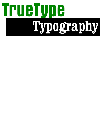
N.B. An asterisk before a word means it has its own entry in the glossary.
- cache
-
An area of volatile memory reserved for fast re-use of computed (or retrieved) data.
TrueType, in common with most scalable font technologies, maintains a cache of character *bitmaps, meaning that each glyph need only be *hinted and *scan-converted once for each size. Subsequent requests for the same character bypass the *rasterizer, grabbing the bitmap straight from the cache. Since TrueType is part of the Mac and Windows operating systems, the implementors were able to provide a dynamic cache, which relinquishes memory to applications as they make demands on system memory. By contrast *ATM uses a fixed-size cache. - CJK
-
Chinese, Japanese, Korean. The fonts of the Far East make particular demands on font technology, often containing hundreds (or thousands) of complex glyphs. Furthermore, very few people combine knowledge of the technology and local typographic expertise. One exception is DynaLab of Taiwan, commissioned by Microsoft to produce fonts for Far East version of Windows.
- ClearType
-
A new implementation of Microsoft's TrueType *rasterizer, incorporating techniques for multiplying horizontal resolution by a factor of 3. By addressing individually the red, green and blue subpixels of an LCD display, text becomes much clearer on screen. (The system provides much less of a benefit on CRT screens.)
Microsoft is being rather coy about the exact method (as you can see on their official ClearType site), but that has merely intensified speculation about it. In his article, Inside Microsoft's ClearType Font Rendering Technology, Steve Gibson gives a convincing account of how the key technique was developed in 1976 for the Apple II computer. - 'cmap' table
-
The part of a TrueType font file where character indices are mapped to *glyphs. See Apple's spec or Microsoft's spec for the format in detail.
- composite glyph
-
A *glyph made up of references to other glyphs.
In most TrueType fonts, accented glyphs are usually defined as composite glyphs, with one reference to the base letter, another to the accent. Each reference to a component contains the glyph number, a 2×2 *transformation matrix (for scaling, rotating, etc.), and a repositioning (either an offset from the component's original position, or a point on the component to match to a point on the glyph being built up. The TrueType specification allows recursive components, i.e. a component may itself be composite.
The *instructions of each component of a composite glyph are always executed. A composite glyphs may be hinted further by its own instructions. - contour
-
A closed shape, part of an *outline. In most fonts, the letters S, i and B have one, two and three contours respectively.
In TrueType, black (solid) contours are defined by clockwise control points, white contours (holes) are defined anti-clockwise. Note that while this is the reverse of PostScript fonts, many people are used to the clockwise black outlines presented by *Fontographer. - CoolType
-
A feature in certain new Adobe applications that allows them to render their own fonts, rather than relying on the presence of an external font *rasterizer like *ATM. Adobe's applications that handle *OpenType (like InDesign and new versions of Illustrator) use CoolType, rather than services provided by the OS, to ensure the fonts are rendered and arranged correctly.
- CSS
-
Short for Cascading Style Sheets. This is the recommended way for web authors to achieve good typograph - much better than doing everything with HTML <FONT> tags. For more information go to: Official W3C CSS Specification or take a look at Microsoft's excellent pages on the subject, Specifying fonts in Web pages.
- cubic curve
-
A mathematical curve representation, whose highest powers are cubics. Cubic *Bézier curves are used throughout PostScript, including Type 1 fonts. TrueType uses *quadratic curves, not cubics.
- 'cvt ' table
-
The optional TrueType table that holds the *CVT if it is used by TrueType *instructions. Values are stored in FUnits. See Apple's spec or Microsoft's spec for the format in detail.
- CVT
-
The Control Value Table contains key measurements ("control values") used amongst several glyphs in a TrueType font, helping to maintain consistency. Most well-hinted TrueTypes would have CVT entries for x-height, cap height, cap stem x, cap stem y, lc stem x, lc stem y - to list a few examples. But any features that should behave similarly at low resolution can be given their own independent CVT entry. CVT values are scaled depending on the current *ppem (along with the glyph's coordinates) and may be altered by the *preprogram. CVT values may be used in all glyph programs. The CVT is the *'cvt ' table in the TrueType font file.
TYPE*chimérique | TrueType Typography | TYPE*links